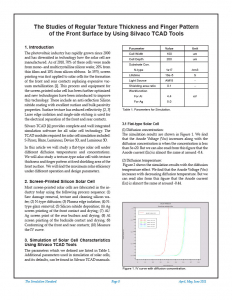The Studies of Regular Texture Thickness and Finger Pattern of the Front Surface by Using Silvaco TCAD Tools
1. Introduction
The photovoltaic industry has rapidly grown since 2000 and has diversified in technology how the solar cell are manufactured. As of 2010, 70% of these cells were made from mono- and multicrystalline silicon wafer, 20% from thin films and 10% from silicon ribbons. In 1975, screen printing was first applied to solar cells for the formation of the front and rear contacts replacing expensive vacuum metallization [1]. This process and equipment for the screen-printed solar cell has been further optimized and new technologies have been introduced to improve this technology. These include an anti-reflection Silicon nitride coating with excellent surface and bulk passivity properties. Surface texture has reduced reflectivity. [2, 3] Laser edge isolation and single-side etching is used for the electrical separation of the front and rear contacts.
Silvaco TCAD [4] provides complete and well integrated simulation software for all solar cell technology. The TCAD modules required for solar cell simulation included: S-Pisces, Blaze, Luminous, Device 3D, and Luminous 3D.
In this article we will study a flat-type solar cell under different diffusion temperatures and concentrations. We will also study a texture-type solar cell with texture thickness and finger pattern at fixed shielding area of the front surface. We will find the maximum solar efficiency under different operation and design parameters.



